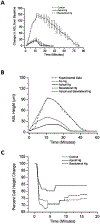Osmolytes and ion transport modulators: new strategies for airway surface rehydration
- PMID: 20439165
- PMCID: PMC8855330
- DOI: 10.1016/j.coph.2010.04.003
Osmolytes and ion transport modulators: new strategies for airway surface rehydration
Abstract
Mucociliary clearance (MCC) in CF lung disease is limited by airway dehydration, leading to persistent bacterial infection and inflammation in the airways. Agents designed to rehydrate the airway mucosa lead to improved MCC. Hyperosmolar agents, such as hypertonic saline and mannitol, create a luminal osmotic gradient, drawing water into the dehydrated ASL. Ion transport modulators function to activate alternative chloride channels and/or to block sodium hyperabsorption that occurs through a dysregulated ENaC channel. Combinations of these therapies may result in a synergistic improvement in airway hydration, and thus, restore MCC. Active ongoing phase II and III trials of new pharmacotherapeutics are covered in this review.
Copyright 2010 Elsevier Ltd. All rights reserved.
Figures








References
-
- Boucher RC. Evidence for airway surface dehydration as the initiating event in CF airway disease. J Intern Med. 2007;261(1):5–16. - PubMed
-
- Matsui H, Verghese MW, Kesimer M, Schwab UE, Randell SH, Sheehan JK, et al. Reduced three-dimensional motility in dehydrated airway mucus prevents neutrophil capture and killing bacteria on airway epithelial surfaces. J Immunol. 2005;175(2):1090–9. - PubMed
-
- Donaldson SH, Bennett WD, Zeman KL, Knowles MR, Tarran R, Boucher RC. Mucus clearance and lung function in cystic fibrosis with hypertonic saline. N Engl J Med. 2006;354(3):241–50. - PubMed
Publication types
MeSH terms
Substances
Grants and funding
LinkOut - more resources
Full Text Sources
Other Literature Sources
Medical

